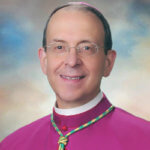Introduction: Passionate Love
Recently I visited St. John the Evangelist Elementary School in Severna Park. I asked a second-grader, “What do you get when you go to Church on Palm Sunday?” He answered, “A long reading!” In fact we listened to two readings. The first described Jesus triumphal entry in Jerusalem. The second described Jesus condemnation, suffering, and death.
The two readings are linked. When Jesus entered Jerusalem to the accolades of the people, some imagined him a military and political figure, others perhaps imagined him to be a celebrity, a worker of wonders. But Jesus harbored no such illusions. He was entering the Holy City because his hour had come – the acceptable time, designated by God the Father for the salvation of the world. He was entering Jerusalem to undergo his passion.
Although this Sunday often is called “Palm Sunday”, its full name is “Palm Sunday of the Passion of the Lord”. Set at the beginning of Holy Week, it is a Sunday in which we accompany Jesus into Jerusalem greeting him not merely as a famous person but rather as the Redeemer of the world who would suffer and die for us.
More than a few people, of course, have trouble making a connection between the suffering of Jesus, his passion, and God’s redeeming love. How are suffering and love connected? It might help if we think about the word passion. In its Latin roots, it does indeed include the notion of suffering. But this same word, “passion”, also has something to do with love. It has to do with God’s passionate love for us: it has to do with the Father’s total love for us, a love perfectly reflected in the obedience of his Son Jesus who became man and who laid down his life for the forgiveness of our sins.
The suffering and death of Jesus mirrors our rejection of God through sin. Jesus’ passion signifies God’s refusal to be put off by our rejection. His love is stronger than our sins. His love is more than death itself. God’s love for us is passionate and pure; jealous and generous.
The Passionists
Of all the days I might have visited St. Joseph Monastery, this particular day in the Church’s liturgical year is the most appropriate. For 127 years, the Passionists, originally known as “The Congregation of Barefooted Clerks of the Most Holy Cross and Passion of Our Lord Jesus Christ” – have served the people of the Archdiocese of Baltimore and this neighborhood.
I hesitate to speak about the charism of this wonderful Order founded in 1780 by St. Paul of the Cross in the presence of the Provincial and several Passionist priests. So I’ll sum it up by saying that the Order was founded to focus the minds and hearts of all people on the Lord’s suffering and death on the Cross. The symbol of the Order, as you know, is a heart-shaped badge, known as “the Sign”, bearing a white cross and three nails with the words, “Jesu Xpi Passio” – “The Passion of Jesus Christ”.
Through the witness of a sacrificial style of life, through common prayer, through retreats and many forms of popular piety such as the passion play “Veronica’s Veil” – the Passionists have been proclaiming the Lord’s great love of us here in Irvington for over a century and a half. This morning, Fr. Joeger, on behalf of my predecessors beginning with Cardinal Gibbons and united with parishioners both past and present, I want offer our deepest thanks! Let me take a moment here to express our warmest thanks to Fr. Thomas McCann and Br. Edward Hall for their faithful service, together with many dedicated lay collaborators. St. Joseph Monastery has also been the source of many priestly & religious vocations, including Fr. Bracken and Fr. Zilonka, and a number of diocesan priests. Fr. Joeger, what the Passionists have accomplished here in the power of Christ’s redeeming love will no doubt be a part of the eternal harvest and will be inscribed in the living memory of this Archdiocese .
A New Chapter
As you know from Fr. Joeger’s letter, the Passionists are concluding their service here, and the Archdiocese will assume directly the pastoral care of St. Joseph Monastery. In the coming weeks, I will appoint a priest-administrator. As this occurs, I continue to pray and to hope that a lively sense of Jesus sacrificial and passionate love for us, a beautiful piety instilled by the Passionists, will be a part of the life of this parish. For it is only by bearing witness to the Cross of our Lord Jesus Christ that we attract those around us to the Catholic faith – Catholics who no longer practice their faith and others who are searching for God’s love in their lives.
May the Lord bless all those who have served here at the Monastery so generously and through His Holy Spirit may we have wisdom to continue proclaiming “to the glory of God the Father, that Jesus Christ is Lord!” May God bless us and keep us always in His love!

